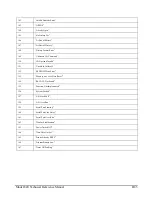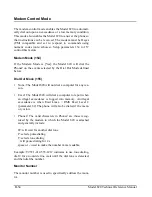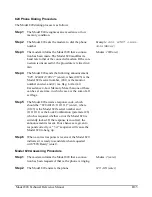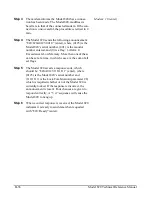
C-10
Model 820 Technical Reference Manual
raindrop; (2) those caused by the movement of air over the dia-
phragm such as environmental wind or blowing; (3) those caused
by vibration of the microphone housing; and (4) those caused by
strong electrostatic fields.
Rules
:
1. Do not permit any solid or liquid to touch the microphone dia-
phragm. Keep a protective grid over the diaphragm.
2. Do not blow on a microphone and use a wind screen over the
microphone to reduce the effect of wind noise.
3. Mount microphones so their body is not subject to vibration, par-
ticularly in direction at right angles to the plane of the diaphragm.
4. Keep microphones away from strong electrical fields.
A microphone measures forces not pressures
. We would like the
microphone to measure sound pressure (force per unit area) instead
of sound force. If the pressure is applied uniformly over the micro-
phone diaphragm a simple constant (the diaphragm area) relates
the two, but if the pressure varies across the diaphragm the rela-
tionship is more complex. For example, if a negative pressure is
applied on one-half the diaphragm and an equal positive pressure is
applied to the other half, the net force is zero and essentially no
motion of the diaphragm occurs. This occurs at high frequencies
and for specific orientations of the microphone.
Rules
:
1. Do not use a microphone at frequencies higher than specified by
the manufacturer; to increase the frequency response choose
smaller microphones.
2. Choose a microphone for
free field
or
random incidence
to mini-
mize the influence of orientation.
A microphone influences the sound being measured
. The micro-
phone measures very small forces, low level sound can run about
one-billionth of a PSI! Every measurement instrument changes the
thing being measured, and for very small forces that effect can be
significant. When sound impinges directly on a microphone the
incident wave must be reflected since it cannot pass through the
microphone. This results in the extra force required to reflect the
sound and a microphone output that is higher than would exist if
the microphone were not there. This is more important at high fre-
quencies and when the microphone is facing the sound source.
Rules
:
1. Do not use a microphone at frequencies higher than specified by
the manufacturer; to increase the frequency response choose
smaller microphones.
2. Choose a microphone for
free field
or
random incidence
to mini-
mize the influence of orientation.
















































